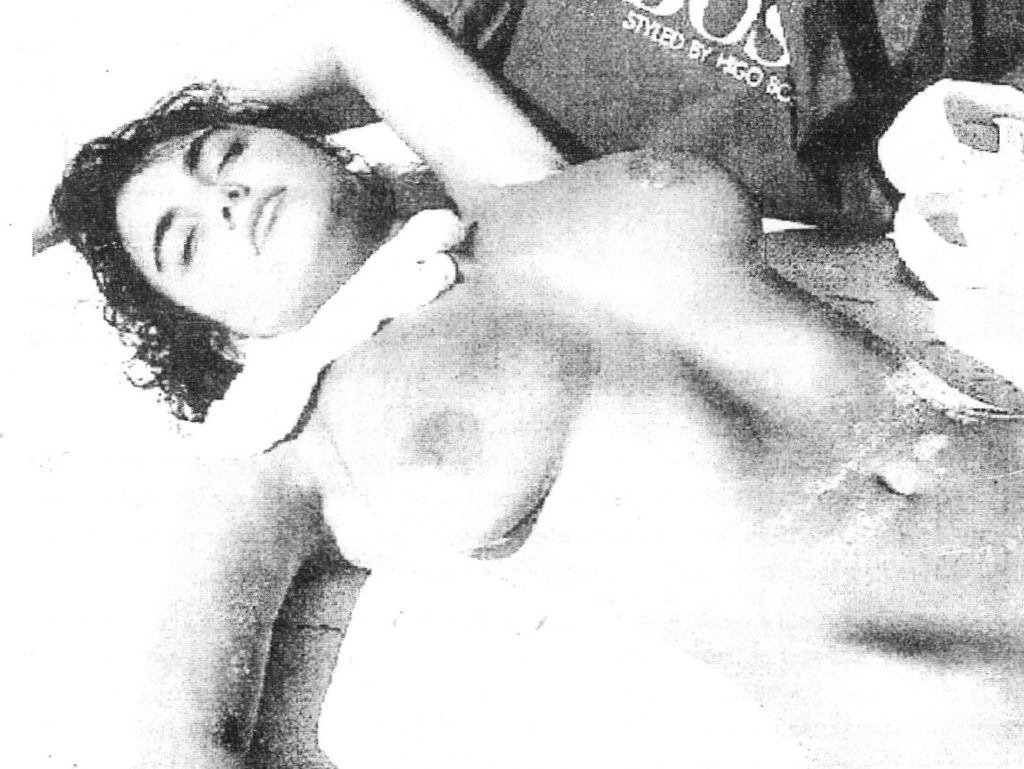Is it life, or is it…
Now that a column dedicated to the Internet has become essential for every magazine under the sun, I see no reason why TC should be any different. And since it seems hard for hack journos to write about the Net without also mentioning the words “porn”, “children” and “disgusting”, why should we buck the trend there either? Though, of course, this being TC, we will also need to use the words “Phoebe” and “Cates”. Don’t worry, all will become clear — eventually…
However, let’s start by wreaking havoc on a few primitive misconceptions. You might think that the Net resembles Soho in its heyday, with sleaze oozing from every electronic orifice. Sadly, this is not so. While not exactly hard to find mildly raunchy material, you’ll also wade through huge volumes of tiresome crap. The absolute independence of the Net, while its biggest strength, means that any geek can become ‘popular’ simply by giving his site a name implying nekkid babes ahoy. Rule #1: little on the Internet ever lives up to what it promises.

The two main ways to obtain pictures on the Internet are via the World Wide Web (WWW) and Usenet newsgroups. The former is effectively an infinite ‘zine – anyone can set pages up. Newsgroups are slightly more structured, in that you subscribe to them, and hope the computer through which you connect also subscribes, but once that’s done, if you post a message, it automatically gets sent to all readers worldwide.
The WWW has become the most publicly visible face of the Internet; hardly a movie comes out now without its own WWW address tucked away at the bottom of the poster i.e. “hhtp://www.hollywood.com/debbie/does/dallas.htm”, and these can also be seen on every kind of adverts from beer to banks. Most of the pics accompanying newspaper scare-pieces come from the WWW, and are tame less for reasons of taste, than because that’s all that is openly available. Sure, Playboy and Penthouse have their sites, but just about everything else is locked out away on “pay-per-view” machines. Given a credit card, these aren’t exactly hard to access, but are scarcely the threat to youth they’re touted as.
The other major problem with the WWW is speed. Even given a relatively fast connection, at best it’s like reading an interesting magazine, v-e-r-y s-l-o-w-l-y. Text is usually fine, but when you come across pictures of any size and quality, it runs like an anaesthetised slug. While this conceivably could be seen as adding a teasing quality to any smut you stumble across, as it slowly reveals itself on your screen, the novelty rapidly wears off. For anything more than trivial stuff, it’s a trial of endurance, and just can’t compare to more conventional media. What’s okay for editors, desperately seeking material to illustrate their animé reviews, is not so acceptable when it comes to good ol’ fashioned undressed totty. A single, good quality, A4 pic could take thirty minutes to turn up on your machine. – by which time, you could have strolled to the newsagents, bought the relevant copy of Mayfair, and read all the articles.
This applies doubly to any computers which do have hard-core material on them. Inevitably, as soon as word leaks out, they are besieged by hordes of ravening British nerds, who swoop like locusts from the electronic sky. Attempt to access any such place you hear about will result in, first, messages telling you the computer is terribly busy, then eventually, the powers that be get fed up with the techno-gridlock and close the place down. It’s just not worth the effort.
The other major problem with the WWW is you can’t do things anonymously. Every home page has to exist somewhere, and while there are people who offer confidential accounts, there are also law enforcement agencies who do the same thing…
Far better from the point of view of the budding pornographer are the Usenet newsgroups. There are somewhere around about 15,000 of these, catering for every conceivable interest, social group, and sexual variation — as mentioned, anyone can post to them, and their message is sent to all the other subscribers to that group. An entire subsection is dedicated exclusively to pictures, and while some members are totally innocent, with pictures of trains and the like, others (see below) would give your local constabulary a fit.
The following Usenet newsgroups are a selection of those likely to contain dodgy pictures. I’ve removed the “alt.binaries.pictures.erotica.” prefix to keep the list manageable. Should give you some idea of the variety of material on offer!
| amateur.female | blondes | female | lesbians | schoolgirls |
| amateur.male | bondage | female.anal | lolita | spanking |
| animals | breasts | fetish | male | teen |
| anime | butts | fetish.feet | mardi-gras | teen.female |
| autos | cartoons | fetish.hair | midgets | teen.fuck |
| babies | cheerleaders | fetish.latex | oral | teen.male |
| balls | child | furry | orientals | thigh-highs |
| bears | child.female | garters-&-heels | panties | uncut |
| bestiality | child.male | gaymen | plushies | uniform |
| big-folks | children | gymnast-girls | pornstars | urine |
| black.females | disney | high-heels | pregnant | voyeurism |
| black.male | facials | latina | redheads | young |
When compared to the WWW, newsgroups have both problems and advantages. It’s not possible to post pictures directly, they must be converted into text beforehand, most frequently using a program called ‘uuencode’. To view them, you reverse the process; it’s all a bit tedious, especially when you’ve no way of knowing beforehand whether or not it’s worth the effort.

On the other hand, almost total anonymity is possible, thanks to devices called remailers, which remove the identifying marks from messages. Though not 100% secure — Scientologists forced the operator of a Finnish remailer to divulge one user’s details — they’ll do for most purposes. And, of course, Britain is one of the few countries in Europe where straightforward heterosexual pornography is illegal: if you’re in Holland, who gives a toss about people knowing your identity? This is the problem with trying to censor the Internet. It’s a global system, so whose rules apply? And how do you apply them? As previously stated, it’s impossible to tell the contents from an encoded file, making policing near-impossible when the volume is taken into account: there may be several hundred new pictures every day, in a single group and any of the 15,000 groups could conceivably contain illegal material. Policing this globally is thankfully impossible.
If you’re in Britain, you might want to be slightly more circumspect, given that somewhere on a computer, there’s evidence to tie you to alt.binaries.pictures.dobermans or whatever. So you might consider doing it all from your local CyberCafe, since you can use their computers with much less chance of being traced, Though you’ll probably get disapproving looks from the CyberDyke at the next terminal as she munches on her organic CyberSalad sandwich.
Do be warned that while possession of pornography is generally not illegal, if there are kids involved, then under British law you are looking at jail, even if no-one else ever sees them. There have already been prosecutions based on material downloaded from the Internet. Worse, this applies regardless of whether the pictures are real or not. There’s a rising trend in artificially created pictures, which mix and match heads + bodies, and are increasingly indistinguishable from the real thing. Thus, you can now go to prison for something that never happened outside of a computer. “Innocent until proven guilty” no longer seems to apply.
The power of modern computers is also used for a (fractionally) more salubrious purpose, or at least one less likely to turn you into a guest of Her Majesty. This is the faking of celebrity pornography. Fancy Gillian Anderson sucking a rather large dick? Or Meg Ryan with semen running down her face? All this, and more, can now be yours. It’s just a modern, technological version of “lookalikes” which have been used in men’s magazines for many years. I have teenage memories of “Debbie Harry” in Men Only, which was passed round at school, and also recall the almighty fuss when some French magazine had a Princess Di lookalike — though nowadays, I doubt if anyone bar Will Carling would be bothered.

At first, black-and-white was favoured, it being easier to match skin tones. But now anything is possible, and the quality of the finished ‘frankie’, as they’re called, is often hard to tell from a real picture. Indeed, the line has been blurred so much that little or no obvious difference exists between a good fake and a good look-alike; for most purposes, they can all be treated in the same way. Of the pictures which illustrate this article, there is one definite fake, one lookalike, and two which I’m unsure about. I leave it as an exercise to work out which ones are which!
Some spend hours fabricating pictures, or trawling the net seeking appropriate material for their iconoclastic fun. To quote one fan, “After a while, it became a fun game to try to recognize the “celebrity look-alikes” either nude or having sex in the pictures I saw on the net. At first, I thought I was the only one who could see the resemblances of celebrities in the pics. It was the ridiculous idea of somebody famous posing in these pictures that struck me as so funny!”
On the other hand, some much prefer reality, even if it comes in the form of blurred screenshots or mere nipples peeking over the top of evening dresses: “I also received email from people who were mad I posted pictures that weren’t real! I didn’t realize how many people take their naked celebrities so seriously…” The major problem is that some frankies are not clearly labelled as such, which does confuse the issue.
The targets tend to be the usual Net-babes such as Alicia Silverstone, with a skew towards those who don’t do “that sort of thing”: nobody bothers producing frankies of Traci Lords, far more fun to do the Pink Power Ranger. The squeakier clean the celeb, the further imaginations are let rip: there are perpetual rumours of a legendary set of pictures depicting Julia Roberts being gang-banged by a sled-dog team. However, it is suspected that ‘legendary’ is all they are..
The purpose behind them is hard to judge. Some may be produced by rabid fans, keen to see what has hitherto been concealed. At the other end of the spectrum are anti-fans, doing it to expose the star in question to ridicule, or merely as provocation. A third group of technically minded individuals do it purely for the challenge. It may be merely for amusement, with no higher agenda than to spread cheer and happiness among those of us who feel no-one is innocent. But before Hollywood starts panicking, one point. With so much artificial celebri-porn around, when a real indiscretion turns up, who’ll believe it? This has already been the case: various allegedly ‘fake’ pictures which appeared on the Internet, clearly labelled as such, turned out to be genuine, from early photo shoots or other factual sources. “Reality” is the only word in the English language that should always be used in quotes, as the late Tim Leary once said.
I wonder what the subjects themselves would think: it’s known that many celebrities have Internet accounts, including Sandra Bullock and Winona Ryder, and it would be fascinating to see what they thought of seeing themselves caricatured in such an intimate way. Would they sue? Indeed, could they? Whatever, it’s an area that’s sure to grow, with the Internet providing an excellent conduit for distribution. As technology continues to escalate, this material is going to become more and more impressive: from fake still photos, the obvious, albeit much tougher, next step is fake movies… Watch this space.
